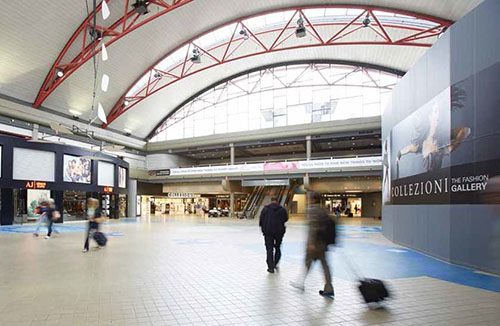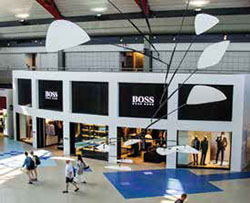Service Changes Lead to New Retail Development at Pittsburgh Int'l
 A $10 million revamp of the airside terminal at Pittsburgh International Airport (PIT) simultaneously addressed two issues: a major change in the nature of the airport's passenger traffic and the need to update its retail concessions.
A $10 million revamp of the airside terminal at Pittsburgh International Airport (PIT) simultaneously addressed two issues: a major change in the nature of the airport's passenger traffic and the need to update its retail concessions.
Completed in July, the renovation opens up the terminal's 80,000-square-foot center core, adds high-end retail options and encourages foot traffic in areas previously hidden from view. PIT officials expect the changes to boost next year's concession revenues by 10% to 20%, based on projections from AIRMALL USA, the firm that manages and develops both retail and food/beverage operations for the airport.
|
factsfigures Project: Retail Revamp Location: Pittsburgh Int'l Airport Cost of Renovations: $10 million 2012 Concession Revenue: $56 million 2013 Concession Spending: $14.16/passenger Concession Developer: AIRMALL USA General Contractor: Shannon Construction Retail Additions: 9 new stores, including int'l luxury brands Design: Lami Grubb Architects Terrazzo Floor Design: Clayton Merrell Floor Installation: Roman Mosaic & Tile Of Note: Renovations are expected to boost concession revenue 10% - 20% |
"The change in passenger flow gave us an opportunity to redefine and redesign the passenger experience as travelers entered the airside core on their journey to the gate," says James R. Gill, PIT's acting executive director. "It's a renovation that looks beautiful and focuses on customer service."
As before, passengers enter PIT's airside area from an escalator that deposits them in the center of the terminal - where they now find a host of new retail options. From there, passengers proceed to gates in four concourses, which are arranged in an "X" pattern.
With PIT consistently posting some of the highest per-passenger spending figures of all North American airports, the recent revamp was critical to retaining its enviable industry position. Last year, passengers spent an average of $14.16 at PIT concessions. Overall concession revenue totaled $56 million in 2012.
From Hub to O&D
For many years, PIT served as a key hub for US Airways. Eight out of 10 passengers landed at the A or B concourse; and 70% of those passengers traveled between the two concourses to make connections. This meant that many visitors rarely ventured to other areas of the airport, and AIRMALL laid out its retail offerings accordingly, explains Jay Kruisselbrink, the company's senior vice president.
The approach worked well until US Airways "de-hubbed" PIT, and the airport transitioned to an origination and destination (O&D) facility. Gill estimates that fully 96% of the airport's passengers now start or finish their flights at PIT.

"That shift took passengers to all four concourses," notes Kruisselbrink. "Instead of the passenger traffic being limited to two concourses near where the majority of our retail was located, it was now spread out evenly among all four concourses. We needed to redo the retail program so that the most customers/passengers were exposed to the most shops."
The project that ensued in January 2013 is the most significant renovation since the airport opened more than two decades ago. Before the recently completed overhaul, PIT's center core only included an information desk and old, television-style Flight Information Display System monitors. During recent renovations, the screens were upgraded to vertical, digital signs and moved to another area of the core along with the information desk. Nine specialty retail stores, including new high-end brands, were added, bringing PIT's overall concession lineup to 76 shops, restaurants, bars and other retail options.
Rerouting Retail Traffic

Lami Grubb Architects, a local Pittsburgh firm, designed the project. "The entire core area has been cleaned up and made into inviting retail space," reports Robert Grubb.
Grubb says that the new configuration "opens up" how the passengers view PIT's concession offerings by grabbing their attention as they exit the escalator and drawing them through the new retail area. "The stores on the back wall had been hidden by some of the stores that surrounded one side of the core," he explains. "We thought that inhibited people from seeing all of the stores, so they were taken out."
The project was divided into phases to minimize disrupting airport operations, and signage helped maintain passenger flow throughout renovations, Kruisselbrink notes. "We had a lot of barricades but (also) had great signage," he recalls. "There were collages of retail and food and beverage as well as directional signs. The signs were key."
Retail tenants coordinated the opening and closing of stores, and fortuitous lease expiration dates helped facilitate some moves, adds Kruisselbrink.
The new retail core includes international luxury brands such as Italian-based Pinko, which chose PIT for its first U.S. location. Other stores include Furla, Lacoste, AJ Armani Jeans, Hugo Boss, Tumi, Spanish-based Desigual and Collezioni-The Beauty Gallery.
Metalsmiths Sterling, a premium U.K.-inspired brand of handcrafted sterling silver jewelry, is another new addition. The store features more than 800 different pieces in diverse styles, with prices ranging from $80 to $2,650.
Demographic data about the airport's passengers prompted AIRMALL to include high-end retail options with international flair, explains Kruisselbrink. Surveys found that 34% of PIT travelers have an annual household income of more than $80,000; and more than half of that group has an annual income of more than $100,000. "That was a pretty good number, indicating we could be successful in bringing in an international higher-end specialty retail mix," he relates.

Lee Konidas, chief executive of Metalsmiths Sterling, considers PIT a unique airport because of its "X" configuration. "(We) recognized an opportunity to be in an airport that is in a transformation with upscaled airport shops and wanted to be included in that mix," he notes.
According to Gill, passengers are responding well to the airport's new offerings. "It's been great to have more of the brand-name, high-end retailers and products represented," he says. "One of the things we are really focusing on is customer service. This refurbishment gives the customer more opportunity to see some of these brands that are not necessarily available in their area, down the street or even in their local mall. So it enhances that part of the customer experience."
Increased concession revenues will subsequently make the airport more affordable for air carriers, he adds.
Grubb summarizes the changes and improvements in one word: modernization. "It is showing some new shapes and new patterns to the circulation in the airport and bringing in a new mix of retailers," he says. "They are all exciting things for Pittsburgh."
Like Grubb, airport officials are pleased with the project's overall results. Gill, however, also has one regret. "I wish we could have done it sooner," he reflects. "As we changed from a hub airport to an O&D, the opportunity could probably have presented itself earlier, but we were spending time adjusting to our new dynamic. If we knew then what we know now, we probably would have done it earlier."
That said, he still considers the recent renovation a "great opportunity" to improve the airport's concession program and overall ambiance.
PIT celebrated the terminal's revamped retail lineup (and the Allegheny County Airport Authority's 15-year anniversary) in late September, with a fashion show and makeup demonstrations featuring products from its new high-end stores.
|
Trading Tile for Terrazzo
Only one main element of Pittsburgh International's airside overhaul remains in process: a public art project made of terrazzo flooring. When the creation is complete, passengers will pass through a noticeably smoother, quieter and more decorative entryway to the airport's recently renovated retail area. New terrazzo flooring will replace thousands of old quarry tiles that required more maintenance and made an annoying "clickety-clack" sound when luggage wheels rolled across them. "Having a beautiful floor that complements the design of the new storefronts, which are marvelous, enhances the entire airport experience and beautifies the airport," says James R. Gill, PIT's acting executive director. The Allegheny County Airport Authority commissioned Clayton Merrell, an art professor at Carnegie Mellon University, to design the 69,000-square-foot project. Merrell's concept, The Sky Beneath Our Feet, depicts a bright blue sky with clouds, aircraft contrails and silhouettes of five Pittsburgh neighborhoods. "This will physically transform the entire airside core of the airport into a giant sky," Merrell comments. "You will walk across one of the neighborhood profiles of these panoramic silhouettes as if you were stepping into the sky ... The image will be rendered in multiple shades of blue and there will be a variety of clouds layered all around to create a sense of scale and perspective." Project planners selected terrazzo for its high quality and durability. Manufacturers create the material by mixing small pieces of quartz, granite, marble and/or glass with a binding agent to produce a resin-like material that is poured into a mold on the floor. Once it hardens, crews polish the terrazzo to create a smooth surface. "After they decided to do a terrazzo floor, they decided they might as well do something great with colors and imagery," Merrell explains. "Basically it's like a giant painting, but it's an acre-and-a-half in size." Installation will occur in phases spread throughout 14 months. Completion is slated for October 2015. |
2022 Charlotte Douglas International Airport Report of Achievement
 Giving back to the community is central to what Charlotte Douglas International Airport and its operator, the City of Charlotte Aviation Department, is about, and last year was no different.
Giving back to the community is central to what Charlotte Douglas International Airport and its operator, the City of Charlotte Aviation Department, is about, and last year was no different.
Throughout 2022, while recovering from the COVID-19 pandemic, we continued our efforts to have a positive impact on the Charlotte community. Of particular note, we spent the year sharing stories of how Connections Don't Just Happen at the Terminal - from creating homeownership and employment opportunities to supporting economic growth through small-business development and offering outreach programs to help residents understand the Airport better.
This whitepaper highlights the construction projects, initiatives, programs and events that validate Charlotte Douglas as a premier airport.
Download the whitepaper: 2022 Charlotte Douglas International Airport Report of Achievement.








